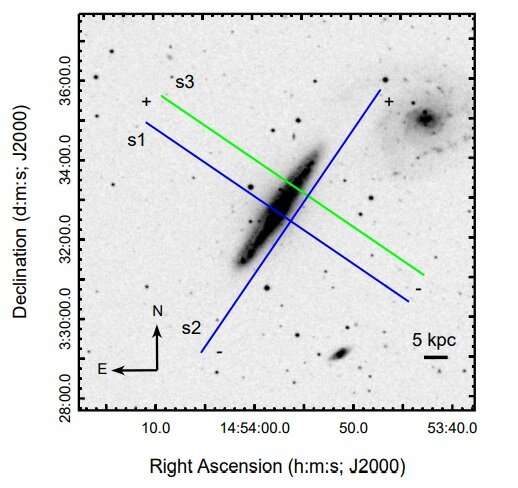October 3, 2019 report
Extraplanar diffuse ionized gas in NGC 5775 studied in detail

Astronomers have conducted a dynamical study of extraplanar diffuse ionized gas layer in the nearby, star-forming, edge-on disk galaxy NGC 5775. The research, published September 25 on arXiv.org, provides crucial information about the properties of this layer, which could help astronomers better understand star-forming processes in galaxies.
Warm ionized gas with temperatures around 1,000 K is called extra-planar diffuse ionized gas (or eDIG). It is known that eDIG has different properties when compared to gas in star-forming regions. Therefore, astronomers are still searching for more evidence of this ionized gas within galaxies, which could provide more details on star formation and galaxy evolution processes.
What puzzles researchers in eDIG layers is that their observed exponential electron scale heights exceed their thermal scale heights by factors of a few in the Milky Way and nearby edge-on galaxies. Located some 94.2 million light years away, NGC 5775 is one such galaxy. It has as a spatially extended, multiphase gaseous halo whose structure and kinematics could shed more light on the disk-halo connection in star-forming systems.
Recently, a team of astronomers led by Erin Boettcher of University of Wisconsin-Madison, performed a dynamical study of the eDIG layer in NGC 5775, hoping to better understand the consequences of star-formation feedback on the dynamical state of the thick-disk interstellar medium. For this purpose, they used the Robert Stobie Spectrograph (RSS) on the Southern African Large Telescope (SALT) and data from the Continuum Halos in Nearby Galaxies—an EVLASurvey (CHANG-ES).
"We combined optical and NUV emission-line spectroscopy from RSS on SALT with radio continuum observations from CHANG-ES to study the dynamical state of the eDIG layer in NGC 5775," the paper reads.
The results of the study emphasize the remarkable spatial extent of the warm ionized halo in the galaxy. It was found that the exponential electron density distribution has both thick disk and halo components, and is asymmetric on the northeast and southwest sides of NGC 5775. The scale heights of these components were measured to be 1,956 and 24,450 light years on the northeast, while 2,608 and 11,736 light years on the southwest sides.
The paper reports the first detection of an increasing eDIG velocity dispersion as a function of height above the disk of a galaxy. The astronomers suppose that such behavior could mean that gas clouds are ejected from the disk with a range of velocities. Hence, the clouds with the highest dispersion are reaching the largest scale heights.
The study also provided further evidence regarding the interaction of NGC 5775 with companion barred spiral galaxy NGC 5774. It is assumed that NGC 5774 is donating neutral hydrogen gas to NGC 5775, enhancing its star-formation rate and giving rise to the multiphase, gaseous halo.
"The interaction of NGC 5775 with NGC 5774, while not directly shaping the kinematics of extraplanar gas in the inner disk, has enhanced the star-formation rate in the former galaxy and thus helped give rise to the vertically-extended, multiphase gaseous halo," the astronomers concluded.
More information: Erin Boettcher, et al. A Dynamical Study of Extraplanar Diffuse Ionized Gas in NGC 5775 arXiv:1909.11679v1 [astro-ph.GA]: arxiv.org/abs/1909.11679
© 2019 Science X Network



















